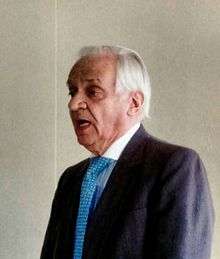Jorge Reynolds Pombo
| Jorge Reynolds Pombo | |
|---|---|
 | |
| Born |
June 22, 1936 Colombia |
| Nationality | Colombian |
| Education | Trinity College (Cambridge) |
Jorge Reynolds Pombo is an electrical and bio- engineer born in Colombia (June 22, 1936, Bogota), self-styled as the inventor in 1958 of the first external artificial pacemaker with internal electrodes.[1][2] He is also a pioneer of whale electrocardiography studies.[3]
Studies and research
During his school years, he studied in Bogotá, Colombia. He went to Trinity College at Cambridge, England, where he graduated as an electronic engineer.[1]
In 1999 he designed a pacemaker for the prevention of thrombosis in tourist class passengers, with the help of Jorge Ulloa.
Since 1991 there have been six underwater acoustic research cruises to study the heart of whales, using submarines provided by the Navy of Colombia as a platform for acoustic studies of whales, with the support of some Navy ships to facilitate investigative work. In his research he has found that the heart of cetaceans and humans are similar and so for more than thirty years he has been studying these animals and then applying the results to humans.
In August 2011, he announced the launch of a pacemaker as small as one-third of a grain of rice, which does not need a battery. Such pacemakers may be seen by cardiologists "from anywhere in the world", he said in the IV Inventors and High Technology Hall in Medellín.
Awards and achievements
Reynolds has received three honorary doctorates in medicine, for his contributions to research and development of technologies for cardiology. Also, add more than 70 productions including documentaries, short, and full-length films made with the help of important scientific channels like National Geographic, and Discovery Channel, among others.
He is a member of at least 34 scientific societies in Colombia and abroad, some of them as an honorary member.[2] He is a member of the Academy of Sciences in New York since 1989, the Colombian Academy of Exact, Physical and Natural Sciences since 1989, and also an Associate Member of the National Academy of Medicine since 2004. He is also a founding member of several scientific societies.
Books
- Voyage to the Heart of Whales (1998)
References
- 1 2 Héctor Cañón (2008). Récords y hazañas de colombianos. Editorial Norma. pp. 171–. ISBN 978-958-45-1525-4.
- 1 2 Levitt, James N. Conservation in the Internet Age: Threats And Opportunities. 1st edition. Washington DC: Island Press, 2002. 212. Print.
- ↑ James N. Levitt (1 September 2002). Conservation in the Internet Age: Threats And Opportunities. Island Press. pp. 212–. ISBN 978-1-59726-851-6.